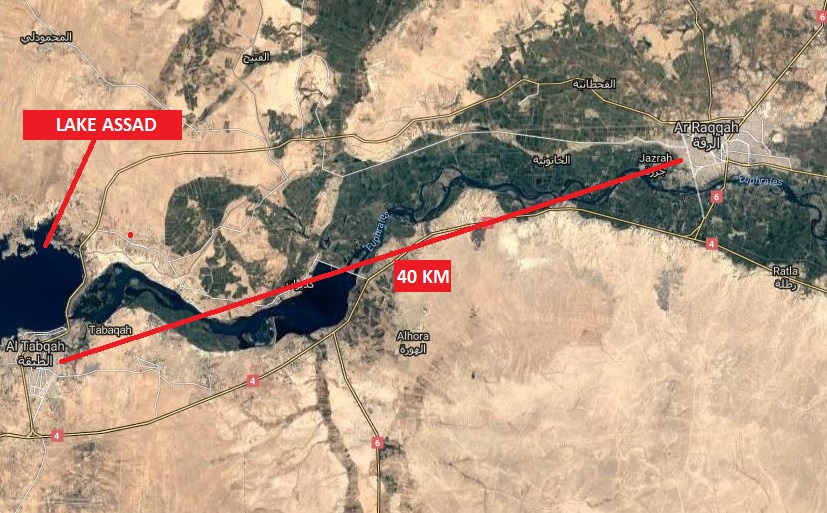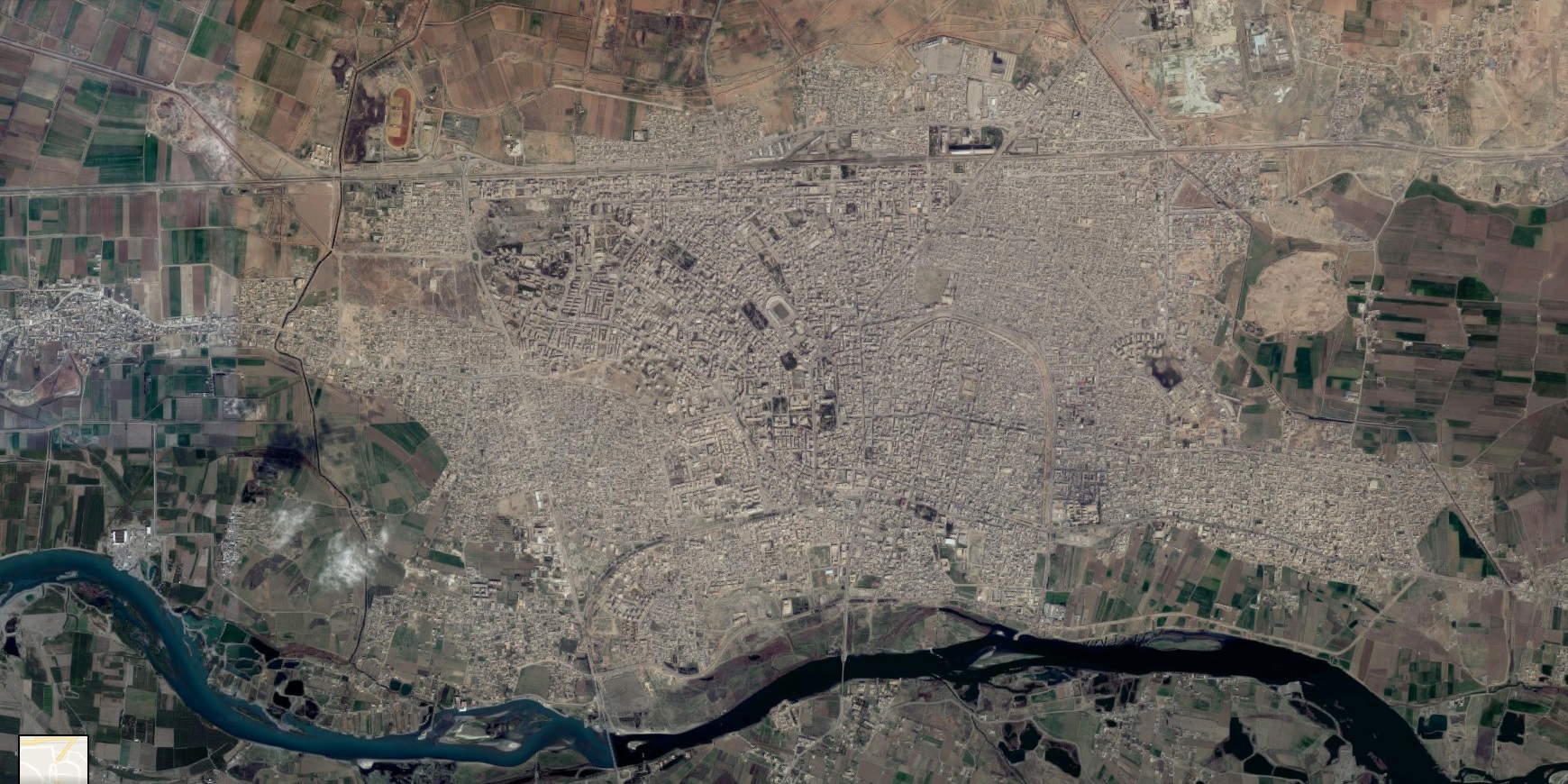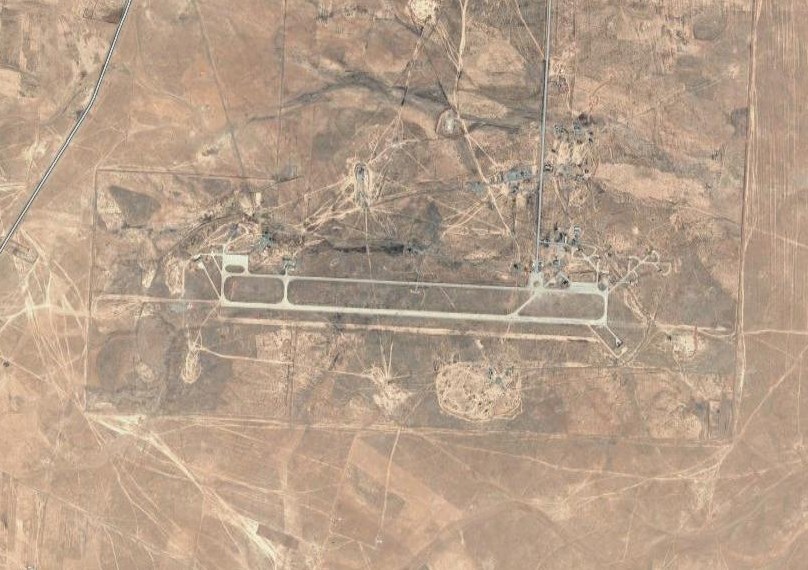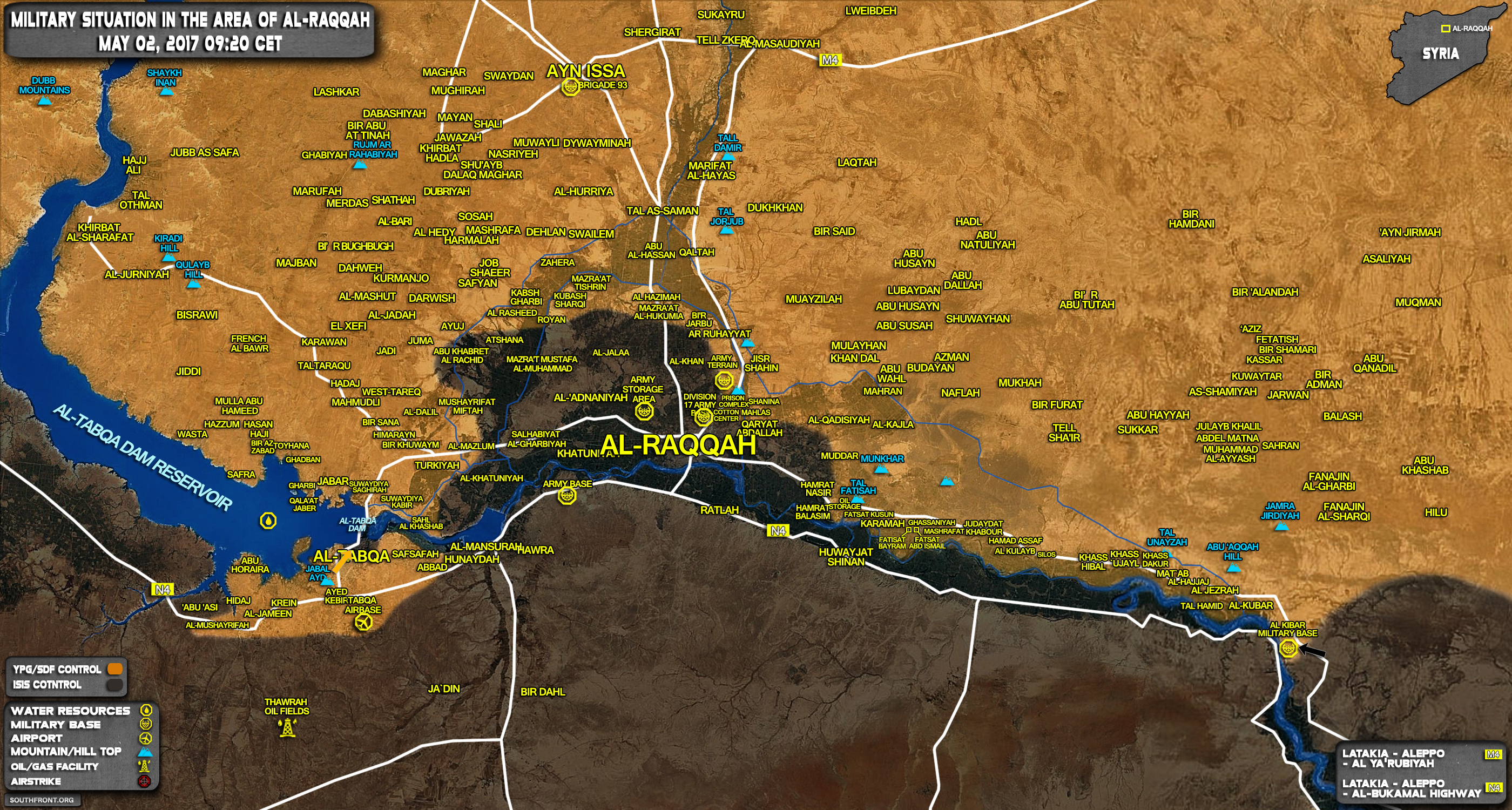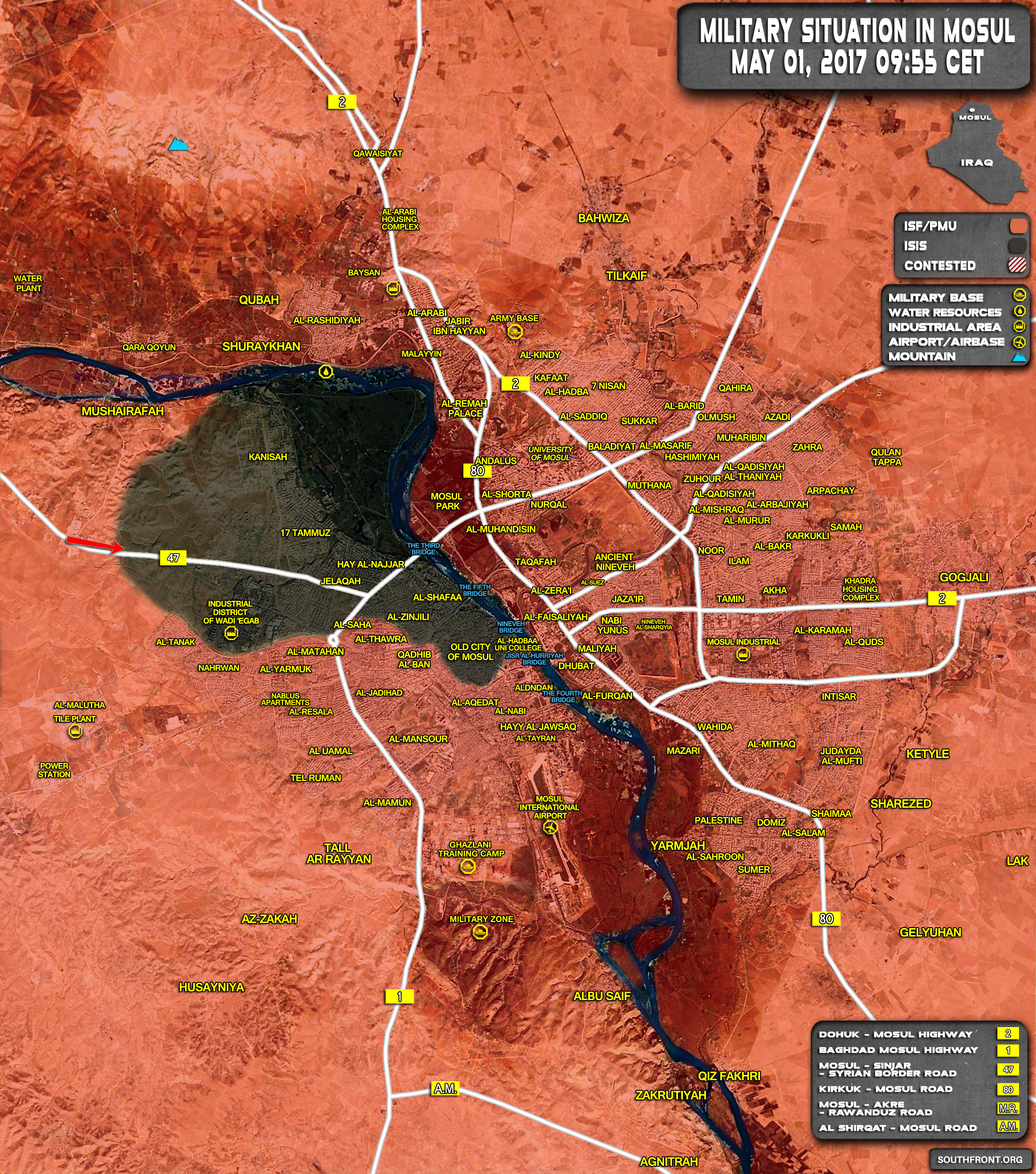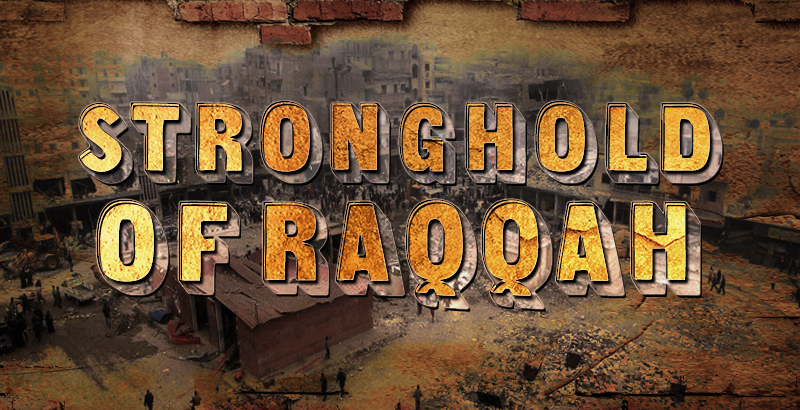
The city of Raqqah is considered one of the most important Syrian cities. The city is located on the northeast bank of the Euphrates River, at the edge of “Sharqiya Syria”, a term used to describe eastern Syria.
Syria’s largest dam, the Tabqah Dam is located 40 kilometers west of Raqqah. The dam is one of the most important electricity and water sources in Syria.
It was built between 1968 and 1973 to generate the hydroelectric power, as well as irrigate lands on both sides of the Euphrates. Syria’s largest water reservoir, the Lake Assad, is located west of the dam. The town of Tabqah and the nearby Tabqah Miitary Airport are located directly south of the dam.
Raqqah is linked with the Syrian industrial capital of Aleppo, the oil-rich province of Deir Ezzor, and the fertile area Hasakah through the M4 Highway. The city’s inhabitants number 220,000 [predominantly Arabs of Sunni Islam; there is also a notable Christian minority], according to the 2004 census. The Raqqah countryside is home to about 100,000 people, most of whom are Bedouins.
The strategic importance of the city as well as the nearby Tabqah dam turned Raqqah into a target for every faction involved in the war and all of them have attempted to take control of it.
At the beginning of the Syrian crisis, Raqqah was one of the calmest provinces, as it did not witness any significant protests or violence. Sporadic protests by opposition groups did not exceed a hundred protestors at their peak.
Thus, Raqqah and its capital became one of the safest provinces accepting scores of loyalist refugees displaced from the Aleppo, Hasakah, and Deir Ezzor where fierce clashes between pro-government forces and militants took place in 2012.
At the end of 2012, Ahrar Al-Sham with the support of Jabhat al-Nusra (the Syrian branch of al-Qaeda; Now it’s known as Hayat Tahrir al-Sham) declared its intention to capture the provincial capital of Raqqah and launched a military operation to do this. Ahrar al-Sham and Jabhat al-Nusra captured the Jirah Airbase and the important town of Maskanah in the province of Aleppo, and entered into the province of Raqqah. Militants captured Tabqah and the Tabqah Military Airport and captured the city of Raqqah after 3 days of clashes on March 6, 2013.
The Syrian Army did not organize any real defenses for the city. This led to many questioning the loyalties of the provincial leadership, which seemingly played an integral role in the loss of this strategic province.
Initially, ISIS activities inside the city were aimed at supporting Ahrar al-Sham and Jabhat al-Nusra in actions against the besieged Syrian Army military installations in its vicinity. However, later ISIS began own operation in order to recapture Raqqah from Ahrar al-Sham and Jabhat al-Nusra. ISIS declared a control over Raqqah in January 2014. A majority of Ahrar al-Sham and Jabhat al-Nusra militants fled, abandoning the entire city to ISIS. Those who remained either defected to ISIS or were executed. ISIS terrorists continued their attacks against Syrian military facilities capturing the Division 17 HQ, the Brigade 93 base, and the Tabqah Military Airport after months of relentless clashes carrying out massacres against the soldiers manning these sites.
While many believe that Mosul is the capital of ISIS, ISIS recognizes Raqqah as its official capital. In the past three years, ISIS was systematically strengthening its presence and influence in Raqqah as it did not face any real danger from other forces involved in the war.
In 2016, following the first liberation of Palmyra, the Syrian Army, backed up by the Russian Aerospace Forces, launched an advance with the goal of recapturing the Tabqah Military Airport and even the city of Raqqah from ISIS. However, government forces did not reach even their first goal and were pushed to retreat after a series of ISIS counter attacks.
The start of the Russian military operation in Syria in 2015 dramatically changed the course of the war and returned an ability to conduct successful operations to the Assad government. The government advance on the Tabqah Military Airport resulted in no gains. Nonetheless, it became clear that if the US-led coalition against ISIS continues ignoring the terrorist group in Syria, the Syrian government and its allies would be able to solve this problem by themselves. [Just for example, in the same year, the Syrian army liberated the city of Aleppo from Jabhat al-Nusra and its allies. This was one of the biggest government victories in this war.] This could become a major diplomatic and PR failure for the US and its regional allies.
In October 2015, the new brand of the US-backed forces appeared in the war. The establishment of the Syrian Democratic Forces (SDF) was declared during a press conference in Hasakah, a town controlled by the Kurdish Democratic Union Party (PYD) and its military wing the People’s Protection Units (YPG). While the US and the mainstream media claimed that, the SDF was multi-ethnic organization, the YPG and the YPJ, the female equivalent of the YPG, became the core of the group. Understanding this problem, the US-led coalition contributed significant efforts in 2016 and in early 2017 to build an Arab faction in the SDF. However, the Kurdish militias remained the undisputed core of the SDF.
On November 6, 2016, the SDF, backed up by the US-led coalition’s air power and special forces, launched the Operation Euphrates Wrath aimed at expelling ISIS from the province of Raqqah.

U.S. special operations forces are seen in the northern Syrian province of Raqqah on May 25, 2016. Delil Souleiman, AFP
Now, the SDF officially includes:
- 36,000 YPG fighters
- 24,000 YPJ fighters
- 20,000 Arab tribal fighters including groups like the Manbij Military Council
Between 10,000 and 20,000 members of the Kurdistan Workers’ Party (PKK) present in the SDF-held area in northern Syria and unofficially participate in SDF military operations. Official representatives of the PYD and the YPG have repeatedly denied this fact because it could negatively impact the US-Turkish relations. An official recognition of this fact will also create a pretext for Ankra to launch a military operation against the SDF. Turkey and a number of other nations describe the PKK as a terrorist group. The Turkish leadership insists that the YPG is just a branch of the PKK.
However, this does not stop Ankara from conducting military strikes on YPG targets along the Turkish-Syrian border. The United States have been pushed to increase its military activity along the border and at a contanct line between the SDF and pro-Turkish mlintants in the province of Aleppo to prevent a possible ful-scale Turkish military operations against the SDF/YPG in northern Syria. Thus, US troops play a role of buffer force between Turkey and the SDF.

A March 5 photo shows a convoy of U.S. forces armoured vehicles driving near the village of Yalanli, on the western outskirts of the northern Syrian city of Manbij. Footage was posted Friday by Syrian activists online showed U.S. armoured vehicles driving on a rural road a few hundred meters from the Turkish border. (DELIL SOULEIMAN / AFP/GETTY IMAGES)
The SDF advance in the Raqqah countryside is ongoing amid an immense fire support from the US Coalition’s warplanes, attack helicopters and artillery. The US also expanded few airfields inside Syria. They are used for delivering supplies to the SDF and as forward bases for US attack helicopters. The US, French and Germany special operations forces also play an important role in supporting the SDF on the ground. The US Marine Corps provides an artillery support for SDF operations around Raqqah.
So far, the SDF has been able to outflank Raqqah from the western, eastern and northern directions, to cross the Euphrates and to capture the Tabqah Military Airport, to capture a major part of the town of Tabqah [May 2, 2016: pro-Kurdish sources announced that the town is liberated] and to set a foothold for securing the Tabqah Dam and isolating the ISIS self-proclaimed capital from the southern direction.
From its side, ISIS began preparing for the Battle of Raqqah since the Coalition’s announcement of the Raqqah operation in 2016.
Since the beginning, it became clear that ISIS was not intending to defend numerous villages in the Raqqah countryside. In turn, ISIS implemented a mobile defense approach. ISIS units were retreating under the pressure of the SDF and the US-led coalition from small villages and were counter-attacking relying on technicals and vehicle-borne improvised explosive devices (VBIEDs).
The goal of this strategy was (and is) to deliver a maximum possible damage to the SDF manpower and military equipment instead of attempting to defend small settlements without any strategic value. Tabqah, the Tabqah Military Airbase and the Tabqah dam were the only locations that ISIS had attempted to defend because of their strategic value – controlling these sites, US-backed forces will have a foothold on the southern bank of the Euphrates west of Tabqah.
Inside and around Raqqah, ISIS started setting up a series of fortifications around the city at the end of 2016 by constructing a high berm and a trench that encircles the city in its entirety. Several local sources also reported that the terrorist group had worked on establishing an intricate series of tunnels, trenches, and cement barriers inside Raqqah.
Furthermore, opposition sources reported that ISIS began lacing explosives and planting IEDs in sensitive areas inside and around the city.
At the turn of 2017 following the success of US-backed forces in Raqqah’s western and eastern countryside and the cutting off of the Raqqah-Deir Ezzor highway in addition to the Syrian Army’s resilience in Deir Ezzor, ISIS began relocating its equipment and ammunition to the insides of the city as well as establishing firing points and sniper nests.
The terrorist group has been also relocating its most experienced fighters to the city. A notable number of elite fighters have been called from Deir Ezzor, Aleppo’s eastern countryside and the Homs desert. Some of them even arrived from Iraq.
In Raqqah ISIS reported has over 10,000 fighters and its most effective armament including TOW and Fagot missiles smuggled from Idlib given to them by FSA factions in Aleppo and Deir Ezzor. ISIS also has stocked weapons like RPG-29 and OSA M-79 for the Battle of Raqqah. Dozens of tanks and armored vehicles have been deployed inside the city. The group is actively manufacturing various kinds of VBIEDs using their stock of explosives.
A military planning, a motivated infantry and a sophisticated usage of VBIEDs are the key strong sides of ISIS forces.
The current goal of the US-led forces is to seize control of the Raqqah countryside putting an additional pressure on the terrorist group from the northern and western direction. It’s expected that the US-led coalition and its allies on the ground will attempt to repeat the Mosul-like operation. However, there is a difference: US-backed forces could leave an escape route for ISIS members south of Raqqah. This could allow to ease the resistance of ISIS members inside the city. Meanwhile, if this is done, many terrorist group members will be able to remain alive and free in Syria. Some of them could then move to Europe as refugees.
The storm Raqqah will include a heavy bombing campaign by the US-led coalition air force with warplanes, attack helicopters and drones, as well as Marine artillery. The United States will expand their military presence on frontlines against ISIS and deploy more troops and military equipment. Like in Mosul, Washington and the mainstream media will likely deny that US troops are directly engaged in a battle against ISIS in Raqqah. However, without an active US military support, the SDF will be hardly able to retake Raqqah from ISIS in a realistic time.

This March 7, 2017 frame grab from video provided by Arab 24 network, shows U.S. forces patrol on the outskirts of the Syrian town, Manbij, in al-Asaliyah village, Aleppo province, Syria. (Arab 24 network, via AP)
ISIS will also use the Mosul exprieience, using well-equipped small groups of fihters, deploying huge numbers of experienced snipers on all streets of the city, and of course the heavy use of VBIED and suicide bombers to attack any gathering of SDF, and to deploy mines and IEDs on all roads.
One of the biggest problems that the SDF will face is a high number of civilians in the city. According to local sources, there are over 250,000 people, including refugees from Deir Ezzor and Iraq, and families of ISIS terrorists in Raqqah.
In general, the battle is expected to last months, and unfortunately, as in Mosul, large numbers of civilians will be killed due to a fighting and the coalition’s bombing campaign. US military officials argue that US-backed forces will start storming Raqqah this summer. Nonetheless, it’s complicated to forecast when the city is retaken from terrorists. Iraqi forces launched their final push towards the ISIS stronghold of Mosul on October 16, 2016 and the city has not been liberated completely so far.
Tensions between the PYD/YPG and the Turkish government is another factor that impacts and slows down the SDF advance on Raqqah.
Meanwhile, the Kurdish-dominated SDF has announced that the liberated city will be included in the the Federation of Northern Syria–Rojava, the YPG/SDF-held area of northern Syria.
This raises a lot of concern in the Syrian government and many pro-government activists question the loyalty of the administration that will rule the city and the people’s desire to join Kurdish federalism, especially after much talk about the racist practices of the Kurdish federal administration in Hasakah and Qamishli against the Arabs. Some speculations even say that if SDF succeeded in controlling the city, it may fail in managing it. However, it is too early to make such far-reaching conclusions.
The liberation of Raqqah is an important part of the broader effort aimed at expelling ISIS terrorists from Syria and Iraq. All sides share this point.
Related articles:



